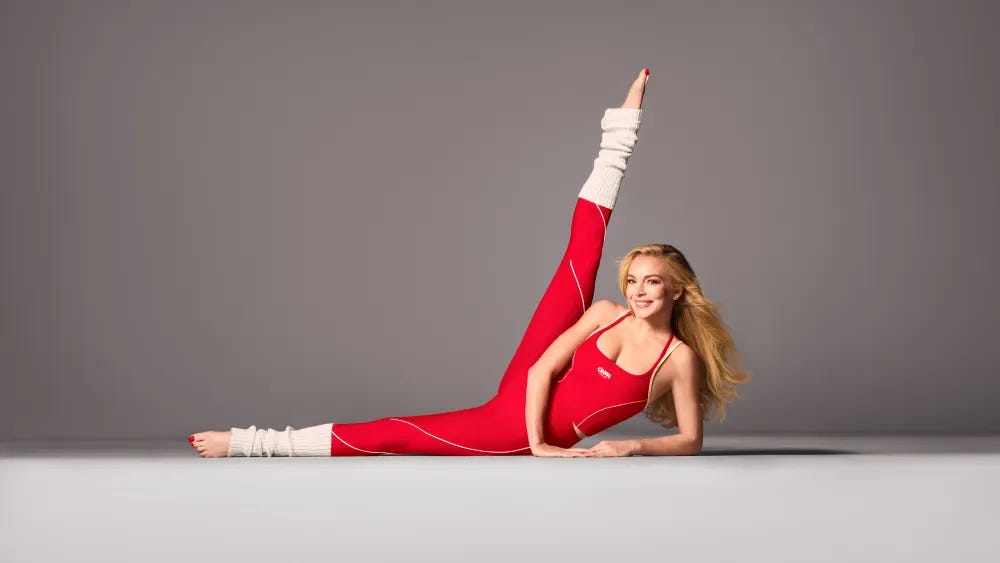Marketing Trend Deep Dive: People Want to Play
A closer look at one of the trends shaping how digital audiences behave in 2025.
Welcome back, Scanner!
Has the summer weather got you feeling energized? Maybe you feel ready to pick up a new hobby, hunt down a Labubu, or dust off last year’s pickleball racket?
Everywhere we look (online and off) people are wanting to play. It was one of the big 5 trends we identified for digital marketing in 2025 – and this trend has not been slowing down. In fact, so much is happening with the play trend that we decided to do a deep dive on it this week. Our signals all relate back to play and how it is shaping the behaviors of digital audiences.
Need a refresher on the trend? Click here to read about it – and then come back to dive into this week’s issue.
Ready? Let’s go.
📅 CURRENT
Lindsay Lohan, Charo, Dylan Efron, and Quen Blackwell Work It Out for Old Navy

What’s changing?
Old Navy has been building up an activewear line and recently launched a campaign for it starring Lindsay Lohan, Charo, Dylan Efron, Quen Blackwell, and others. The campaign, “Old Navy, New Moves,” started with in-theater advertising and will ramp up to include TV spots, social campaigns, emails, billboards, and more. Think: Stars doing vigorous workouts to “Whip It” in bright, tight activewear.
Why does it matter?
The campaign is a weird and wonderful mix of people; the strategy is chaotic. Old Navy deliberately chose an eclectic mix of celebrities that defy traditional demographic targeting, creating conversation and fun through unexpected combinations. It isn’t your usual fitness influencer or athlete in these ads. This campaign emphasizes fun over athletic performance. While we can’t say it isn’t “for the meme,” the randomness of it all makes it super share-worthy. There’s nostalgia to it and, in a way, the random mix of stars feels more genuine. The core of this marketing strategy is entertaining, leaning into fun rather than exclusivity, and speaking directly to Old Navy’s diverse target audience.
What could happen next?
How can (and might) more brands lean into the play trend? By choosing the unexpected. Could that look like more brands partnering with older entertainers or nostalgic figures? Mixing generations and levels of celebrity in campaigns? Sometimes in these hyper-optimized digital landscapes, randomness becomes a superpower. As AI and algorithms deliver exactly what people should want, brands have an opportunity to shake things up and delight with the unexpected. Choosing play might just look like deliberately choosing surprising (non-computer generated) combinations for human authenticity.
Scan-o-meter: 📅 📅 📅 📅 / 5
😲 SURPRISING
Oscar Meyer Launches the Wiener 500 “Dog” Race
What’s changing?
Oscar Mayer and Fox Sports have joined forces to launch the “Wiener 500” – a race between six “Wienermobiles” that will happen as a lead-up to Fox Sports’ coverage of the Indianapolis 500. Aptly nicknamed a “dog” race, the Wienermobile race is a playful reference to both the Indy 500 and dog races.
Why does it matter?
While most brands spend dollars on ad spots during the race, Oscar Mayer created entertainment content of its own (that has genuine appeal). The campaign has a ton of touchpoints; including being live streamed on the Fox Sports app, broadcasted on the Fox TV network, and shared on social media. It also creates a shared moment that people can enjoy annually (that conveniently kicks off the summer grilling season). The campaign is a little unhinged, a bit absurd, and totally shareable.
What could happen next?
Will we see more companies hop on this and create their own sporting events (drop what brand or activations you’d like to see in the comments below)? Does this open up the creative potential around partnering with events that are already happening in new, interesting ways? There is an element to this signal of disruption; turning advertising into entertainment. Who else will lean in? Something our team has been talking about lately is “embracing the cringe,” could this campaign lead to more of that? Trying to be authentic instead of “cool?” And, finally, it’s a great reminder that absurdity itself signals that real humans made creative decisions rather than algorithms optimizing for engagement. How can we continue to keep this playful human touch in our content?
Scan-o-meter: 😲😲😲 / 5
🎯 SPECIFIC
First: ChatGPT, Now: Roblox

What’s changing?
You can now buy real products in Roblox. The game started out with selling digital Gucci and Burberry bags, and now sells real clothing and beauty products (starting with Fenty Beauty) right inside the platform. Starting earlier this month, approved brands, creators, merchandisers, and intellectual property holders have been able to sell physical products within a shoppable Roblox experience. In partnership with Shopify, Roblox has introduced “Commerce APIs” that sell both a physical product and a digital replica for use in Roblox as well.
Why does it matter?
This move by a major platform like Roblox creates a new customer journey experience that’s sure to set a precedent for other digital platforms. Getting both a physical and digital replica of your item creates a multi-verse, immersive experience for users that offers plenty of dopamine. Being able to purchase in-platform is the cherry on top. It creates an opportunity for brands to create entire virtual experiences around their products before customers buy the physical items. We know that Gen Z hangs out regularly in these spaces, so Roblox is going right to where their younger consumers are, their preferred digital environment, instead of forcing them onto traditional e-commerce sites. And, it transforms gaming further into a social ecommerce space (that goes far beyond entertainment).
What could happen next?
Will we start to see the other major gaming platforms (like Fortnite or Minecraft) integrate this shopping structure into their features? Will we see virtual try-on experiences become more sophisticated, with additional bridges between the digital and physical experience of their products? How will this affect gaming creators? Will we see them become even bigger forces in retail, as opposed to mainly entertainment? For users, will we see virtual avatars become more central to our online shopping experiences? How long will it be for the general public to expect a larger digital element to their shopping experiences? There is so much to consider here, but the thread through it is: shopping can (and will) be more playful.
Scan-o-meter: 🎯🎯🎯🎯🎯/ 5
🔍 TREND REPORT IRL
Updates from our Trend Forecast
We recently shared our second Trend Report with you! As the year goes on, we’ll continue investigating signals that further the conversation around our two forecasts. Here’s what we’re watching this week:
People want realness: The Chicago-Sun Times published made-up books by fake experts – oops.
People want shared moments: The hottest artist in the underground dance scene is a horse.
People want to play: The Nintendo Switch 2 is already sold out (before release)!
Want more trend news? Check out What (Digital) Audiences Want In 2025!
🤔 BEFORE YOU GO
To help keep these signals top-of-mind, we share 1 question to ask yourself (or your team) in each edition. Your question to mull on this week is:
See you next time 👋





